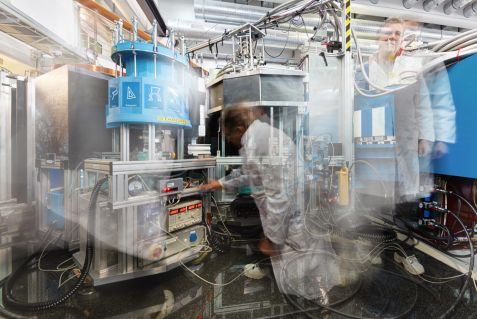MLZ is a cooperation between:
 > Technische Universität München
> Technische Universität München > Helmholtz-Zentrum Hereon
> Helmholtz-Zentrum Hereon
 > Forschungszentrum Jülich
> Forschungszentrum Jülich
MLZ is a member of:
 > LENS
> LENS > ERF-AISBL
> ERF-AISBL
MLZ on social media:

MLZ (eng)
Lichtenbergstr.1
85748 Garching
26.11.2020
The frustrated “third wheel” in a magnet
Scientists of the Technical University Munich (TUM) and the Ludwig-Maximilians-Universität (LMU) in Munich investigated frustrated quantum magnets with neutron scattering at the MLZ. They published their results in the prominent journal “Annalen der Physik” – a showcase for luminaries such as Wilhelm Conrad Röntgen, Max Planck, Albert Einstein, and Erwin Schrödinger, who also published their results here.
Material scientists and crystallographers under the direction of Prof. Dr. Nataljia van Well from the LMU have prepared the compound Cesium-Copper-Chloride doped with various amounts of bromide ions (Cs2CuCl4-xBrx) and investigated it with neutron scattering at the MLZ. This compound exhibits a form of geometric frustration, an interesting phenomenon that can manifest itself when materials are cooled towards absolute zero. The scientists investigated which temperatures, applied magnetic field strengths, and chemical compositions mark the boundaries of the frustrated phase in this material.
What do physicists mean by frustration?
Every physical system always strives to settle into its most stable state, i.e. the state with the lowest energy. There are countless examples of this in everyday life: e.g. unstable objects falling over or hot objects cooling down to match the ambient temperature.
The crystal structure of Cesium-Copper-Chloride corresponds to that of a tetrahedron (a pyramid with a triangular base) with atoms located at the corners. It is helpful to focus on the triangular sides the tetrahedron to see how geometric frustration arises. The spins (which behave like small magnets) of the Cu atoms are free to rotate about their respective axes, but like everything else in the world they also strive to reach the minimum energy state. In this system, this is achieved when all spins are oppositely aligned with their closest neighbors. And this is how conflict arises: if two spins in a triangle are aligned against each other, then third one is frustrated because it cannot simultaneously be aligned against both its neighbors. Thus no matter how this third spin orients itself, it never reaches a minimum of magnetic field energy.
The enhancement or suppression of this frustration gives rise to the different magnetic phases observed in these types of compounds. The transitions from one magnetic phase to another are interesting because they provide essential information about the fundamental quantum mechanical interactions between the individual spins, thus enabling a fundamental understanding of the material.
How do you study frustrated magnets and why are neutrons particularly suitable?
Dr. Robert Georgii and Dr. Markos Skoulatos, both instrument scientists at the MLZ instrument MIRA, cooled the substance Cs2CuCl4-xBrx to within 0.05 degrees above absolute zero and applied a magnetic field through it. Since neutrons have a magnetic moment (spin), they are scattered by the magnetic structures formed from the electron spins in a material, similar to how two regular magnets would interact with each other. From the data, they determined the atomic level spin orientations of the magnetic Cu atoms in Cs2CuCl4-xBrx.
What is the difficulty in this experiment?
The growth of the crystals is an extremely difficult task that requires a lot of experience and expertise. This is because crystal growth is very time-consuming, and in this case it took almost 8 months. The compound is also extremely susceptible to any non-ideal influences or disruptions, and during the crystallization process, these must be completely prevented in order for the intended crystal to properly form. Moreover, this enormous sensitivity warrants minimizing the time the crystal spends in transit. Here the researchers made optimal use of the geographical proximity of the universities, the experience at LMU in crystallography, and the neutron scattering capabilities at the Heinz Maier-Leibnitz Center.
And yet it moves!
In a typical magnet, all the spins close to absolute zero would align in a static minimum energy configuration. When no such energy minimum is reachable due to geometrical frustration, no uniform alignment is possible. This state of matter is dubbed a quantum spin liquid and is an important topic in basic research, and could be relevant in future quantum computing schemes. From our experience in the macroscopic world, we might expect that everything becomes frozen (perfectly still) near absolute zero. But as this experiment shows, spins can still move around at absolute zero due to quantum mechanical fluctuations.
Original publication:
Natalija van Well*, Sitaram Ramakrishnan, Ketty Beauvois, Navid Qureshi, Eric Ressouche, Markos Skoulatos, Robert Georgii, Oksana Zaharko, and Sander van Smaalen: Magnetic-Field-Controlled Quantum Critical Points in the Triangular Antiferromagnetic Cs2CuCl4-xBrx Mixed System. Annalen der Physik, 09.06.2020. DOI: 10.1002/andp.202000147
MLZ is a cooperation between:
 > Technische Universität München
> Technische Universität München > Helmholtz-Zentrum Hereon
> Helmholtz-Zentrum Hereon
 > Forschungszentrum Jülich
> Forschungszentrum Jülich
MLZ is a member of:
 > LENS
> LENS > ERF-AISBL
> ERF-AISBL
MLZ on social media:



